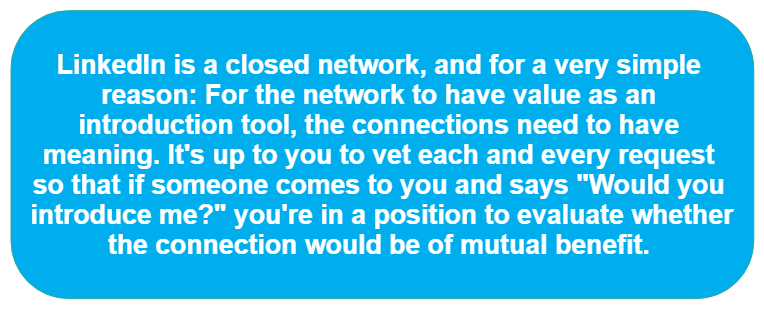Sometimes I feel like a broken record, not all connections on LinkedIn are good. Quite often they can be detrimental to you, your business and the perception of value to your audience, clients and casual viewers.
One of my favourite quotes ever is from Reid Hoffman, the founder of LinkedIn:
Often people are flattered to be asked to connect but are horrified when we share our research that 80% of connection requests do not respond if you send them a note and ask why they want to “connect”. They don’t really want to connect; they are just going through the motions if I am being positive or looking to proactively steal your data if I’m being negative
Let me explain why all connections might not be the best connections:
Steal your data
Everyone you connect with on LinkedIn by default can see every other level one connection you have on LinkedIn – think of it like giving every connection a copy of your address book or inviting them into your home. Even if you hide your connections in your settings it is still exposing for you and not in a good way! Find out more in a previous blog of ours.
Leak future direction, strategies and intellectual property
We’ve had several cases now of over connected boards being serious exposed through connections. How? Simple. Sharp analysts and more are checking the number of connections you have around strategic themes such as mergers, acquisitions, debt, finance and more, hence exposing where you might be heading as a business. When you update your profile with new skills, areas of focus or plans it is all visible and some high-profile press has been fuelled through this.
Reputation risk
If you think of LinkedIn as a room full of business professionals would you chose to hang out with a bunch of losers or nice people? If someone looks you up on LinkedIn, they can see the people that they know that know you, that says a lot about you.
They might be losers, recruitment consultants, insolvency experts and more – what would that say about you? I bet you’ve shied away from someone at a physical networking event because of who they were talking to – it’s no different on LinkedIn, just faster.
Value / Cost exposure
Would you be shocked to learn that M&A firms, credit companies, banks, insurance and more all look at your personal LinkedIn to help them decide if you’re their sort of client? Well they do. What about the due diligence teams in M&A firms looking at profiles as an indication of that business’s leadership team? And yes – they do that too.
Procurement exposure to your income or competition
The number of people we work with that get excited about procurement “reaching out” to them with a connection invite astounds me.
Yes they might want to chat in a positive way but if you were a consultant or accountant for example they might want to use your full LinkedIn profile (once you’d accepted the invite) to help them gauge your income by looking at your home address on Google Street View for example or analysing that holiday pic on your profile!
You can even make it easy for them to find one of your competitors if you have foolishly let them within your network – this makes it ever so easy for procurement to find someone to bid or quote against you for the work you were hoping to get.
More people meet your professional profile than meet you and hence your LinkedIn profile, use and network represents you and your value to the business world.
Those good connections that you have can really help as indicators and advocates of the value of knowing you and your business impact in real life.
The same can’t be said of the ones you don’t know.
